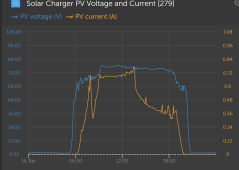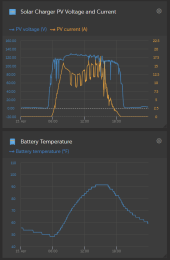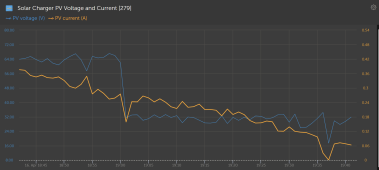TerryTtibbs
New Member
- Joined
- Mar 15, 2022
- Messages
- 56

Just running a test rig with some small sla's to track the data with new panel setup before finalising install.
This is a 16-18 Degree C day with no sun and just heavy cloud northern hemisphere (London). My 2 x 345W Qcell panels on short circuit mid day facing south lying flat on the ground are giving me 80VDC @ 4.4amps averaging 3.2amps (rated at 10amps -11amps at full output STC) max and 82V output.
The current (A) is only showing charging cycles from float to bulk throughout the day as only a very small invertor is connected just to give a 15W -25W load overnight for testing purposes.
The above graph is showing 24 hour data for 2 x 345W Qcell panels series charging small 7Ah 48V pack at 1.0A max charge set in the MPPT just for testing purposes.
I am very impressed with the output from these panels in low light. Much higher than I expected. I am also very impressed with the efficiency of the Victron MPPT.
I would like opinions from people with real world experience which route to take next!
array=4 physical panels for the purpose of this analysis.
I will have 3 arrays in total, 1 facing South, 1 West and 1 East with various shading across all arrays that cannot be avoided due to surrounding buildings.
I would really like to keep the arrays in 2 strings each of 2 series panels and use a dedicated MPPT for each string. I like the idea of having a low voltage @80VDC PV solar output with dedicated tracking per string with no shading.
However I would like opinions from people with vast experience on whether I should change my array to 3 panels series of 1 string.
The current locations of the arrays are much more suited to 4 panels portrait wide as I have a limitation of 4.2 meters in mountable width for each array (4 panels wide). HOWEVER there is shading early morning and late evening across all of the arrays at about 50% vertical with the panels arranged in portrait from left to right on each array. This is why my preference has been to track each string using individual MMPT per pair of series panels.
If I go to 3 panels it will leave 1 panel on the end of each array on its own facing in different directions, south, east and west, which to me seems pointless.
I understand I am cutting it fine for a 48V system needing 51.2V + 5V for MPPT activation) for bulk phase charging. My calcs show PV voltage 134mv drop per degree above 25 Degrees C which is only 3V including efficiency 98% maximum drop from the figures shown in that chart above even in hot days. This still leaves me headroom.
Will there be any point in going to a 3 panel string with shading across 30% of the string at various times of the day? Will it make any difference to when my string will start charging in a morning having 3 panels instead of 2 in the string?
My climate rarely exceeds 28-33 degrees C in summer and down to -12 degrees C in winter.
Before I install 1 MPPT 100/20 (6 in total) for each pair of series panels please let me have your thoughts, as otherwise I will need 4 x MPPT 150/35 with a potential shading issue on all series strings.
Going to 4 panels in series 160VDC with MPPT 250/60 is not an option as I don't want to exceed 125VDC PV per string.
From what I have been reading if cost is not a problem then assigning multiple MPPTs in smaller strings is more efficient for the way the Victron MMPT software is coded.
Anyone else with a 2-3 panel series setup please post your 24 hour data so I can see the V and A figures.
Regards
Last edited:




